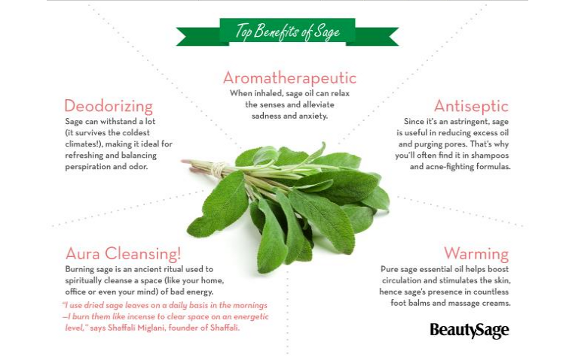Infographic: The Benefits of Sage – A Super Healing Herb

 There are many herbs you likely use in your kitchen which offer a wide range of health benefits. Sage, and its nearly 900 species, are just one of these multi-tasking herbs. In Latin, sage is known as salvia, and it’s no coincidence that salvia means “to heal.” Keep reading to check out a cool infographic on sage, as well as to discover the many benefits of sage.
There are many herbs you likely use in your kitchen which offer a wide range of health benefits. Sage, and its nearly 900 species, are just one of these multi-tasking herbs. In Latin, sage is known as salvia, and it’s no coincidence that salvia means “to heal.” Keep reading to check out a cool infographic on sage, as well as to discover the many benefits of sage.
Sage has a long and rich history. In the 10th century, Arab healers believed it promoted immortality. Ancient Greeks and Romans used it in spiritual gatherings and to reduce the spoilage of foods. Native Americans have long utilized sage in spiritual rites, believing it to be a purifying herb worth using in smokes, teas, baths, and poultices.
It’s a member of the same family as rosemary (read more about rosemary benefits here) and mint, and like these other healing herbs, sage has both anti-inflammatory and anti-oxidant benefits. Loaded with flavonoids and phenolic acids, the herb is able to fight oxidative stress and the many symptoms of inflammation throughout the body.
Since sage is a natural antiseptic, helping to reduce excess oils and cleanse pores, you’ll often find sage in shampoos and natural acne treatments. Its presence in massage creams is because of its ability to help promote healthy circulation. It’s also a powerful aromatherapy tool and can reduce feelings of sadness and anxiety.
Read: 9 Amazing Healing Herbs
Perhaps one of the most useful benefits of sage is found in its anti-inflammatory properties. This means it can be used to lessen the symptoms of everything from asthma to arthritis. Because conditions like diabetes and blood pressure are also linked to inflammation, adding sage to your cooking or your tea could help your body counter these life-long and wholly preventable problems.
Additional benefits of sage include:
- Anti-perspirant
- Deodorant
- Liver detox
- Cough suppressant
- Sore throat relief
- Fights gum disease
- Relieves cold symptoms
- Aids in digestion
- Relieves diarrhea
You can take sage in your tea or add it to your cooking. While you can find it at the store, growing it yourself is even better; you can even reap the benefits by chewing on the fresh leaves while you’re out in the garden.

